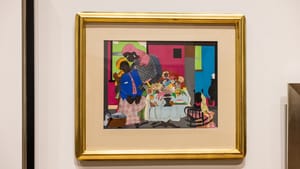Stay in the Loop
BSR publishes on a weekly schedule, with an email newsletter every Wednesday and Thursday morning. There’s no paywall, and subscribing is always free.
Proving Black art's place at the center of American history
Arthur Ross Gallery presents David C. Driskell and Friends: Creativity, Collaboration, and Friendship

David C. Driskell (1931-2020) identified a gap that the art world of his time refused to acknowledge. Curating a 200-year survey of Black American art in 1976, he flouted conventional wisdom by demonstrating that Black art in America had as long a history as America itself. Driskell, who spent his life validating Black creativity as an artist, curator, educator, and mentor, is celebrated in David C. Driskell and Friends: Creativity, Collaboration, and Friendship at Arthur Ross Gallery.
The first task in mounting Two Centuries of Black American Art, 1750-1950 at the Los Angeles County Museum of Art (LACMA) was to establish the topic’s legitimacy for a skeptical power structure. Driskell succeeded so well that he is now credited with laying the foundation for the academic study of Black American art.
Domestic intimacies
Several artists here were among the 63 included in the LACMA exhibition, such as Romare Bearden (1911-1988), Elizabeth Catlett (1915-2012), and Charles White (1918-1979). They and the others on view, including Driskell himself, reveal the uniqueness and universality of Black life in varied media and styles.
Bearden’s painting Morning (1975) shows two women at a kitchen table. One has arisen and leans toward the other as if to kiss her goodbye. His collage Family (1970) captures adults and wisps of children gathered around a cradle in a clapboard room lit by a kerosene lantern.
Catlett’s sculpture Seated Mother and Child (1982) depicts a woman soothing a baby peeking over her shoulder. And White’s lithograph Awaiting His Return (1945) reveals the agony of uncertainty in the face of a haggard woman. White intensified tension in the composition by forming her entirely in sharp angles and explained her worry with a starred banner hanging on the wall—a symbol of a family member serving in World War II.
Margo Humphrey (b.1942) updates Catlett’s mother in The Black Madonna (2013). Pietà-like, the lithograph depicts a tearful woman holding the outstretched torso of her young son. He appears to be dead until we notice the bag of Skittles, open and spilling, clasped in his left hand, and his right hand, raised against his mother’s chest in a tiny power salute. Then it’s clear that the Madonna’s tears are for the future, if her assertive little boy raises his fist at the wrong time, to the wrong person.
Legacies of slavery and freedom
Slavery is addressed in several works, including Jacob Lawrence’s (1917-2000) serigraph To Preserve Their Freedom (1988), in which armed escapees flee through tall grass. Lawrence relies on colorful geometric forms with just a few lines denoting brows, eyes, and weapons.
Melvin Edwards (b.1937) shows what they fled in Untitled (chains) (2005), a simple etching of a necklace of heavy chains, and Cunene (1986), a bronze fusion of chains, spikes, screws, and a horseshoe—a threatening sconce, hanging high. The menace is clear without knowing Cunene is the name of an Angolan province.

Serigraphs from Betye Saar’s (b.1926) series Bookmarks in the Pages of Life (2000) introduce High John De Conquer, an African American folk figure related to conjuring and the hope of freedom. Author Zora Neale Hurston identified him as a clever slave. In one image, Saar depicts him in priestly white vestments with a long red cape. In another, he’s a supporting player: Saar included a man in a suit and top hat, and a ticket to a De Conquer appearance, in a collage of field workers and sheet music.
A groundbreaking career
In 1977, Driskell joined the University of Maryland, where he remained for the rest of his career, chairing the art department, becoming a distinguished professor, and after retiring, being honored with the 2001 establishment of the David C. Driskell Center for the Study of Visual Arts and the Culture of African Americans and the African Diaspora. The Driskell Center organized this exhibit.
Driskell the artist dealt mostly in abstraction. His serigraph Gabriel (2018) centers the viewer in a kaleidoscopic image, eye-level with the bell of a trumpet being played for all it’s worth. Color stands in for the notes we can only imagine.
Driskell’s gorgeous abstractions Linear Patterns #3 (no date) and Five Blue Notes (1980) are exuberant yet orderly, capturing eyes with vibrant color and holding them with intricate design. Linear Patterns, a collage, suggests an interplanetary flag and in the painting Five Blue Notes, Driskell wove ribbons of red, white, and yellow over a blue field studded with bright brushstrokes.
A forest of creativity
At his home and studio in Falmouth, Maine, Driskell needed only gaze outside for inspiration, writing, “Trees by their very nature connect past with present and bear multiple histories and generations.” As artist, curator, educator, and friend, Driskell functioned much the same, connecting Black art and artists with museums and collectors, enabling the world to see a forest of creativity that was there all along.
What, When, Where
David C. Driskell & Friends: Creativity, Collaboration, & Friendship. Free entry with advance registration. Through September 15, 2024, at Arthur Ross Gallery, University of Pennsylvania, in the Fisher Fine Arts Library Building, 220 South 34th Street, Philadelphia. (215) 898-2083 or arthurrossgallery.org.
Accessibility
The wheelchair-accessible entrance to Arthur Ross Gallery and Fisher Fine Arts Library is through the Duhring Wing on the building’s south side opposite Irvine Auditorium. To access the entrance, call (215) 898-2083 in advance or (215) 898-1479 (guard’s desk) when on site.
Sign up for our newsletter
All of the week's new articles, all in one place. Sign up for the free weekly BSR newsletters, and don't miss a conversation.
